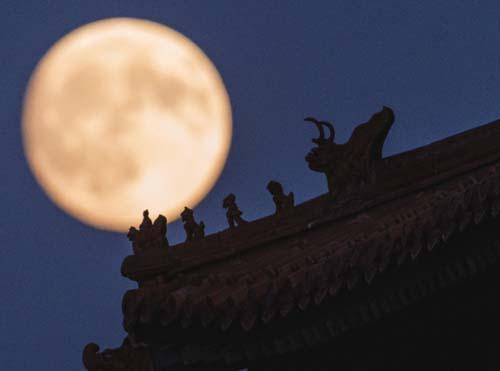Over the Moon
By Francisco Little
If youre going to express your love for someone special in your life, doing it beneath the light of a full moon is guaranteed to place you at the top of the romance spectrum.
In China, during the Mid-Autumn Festival, the moon is the guest of honor and along with connecting hearts, it ushers in the nations insatiable desire for the most delicious confectionery in the East: the mooncake.
Second in importance only to Chinese New Year, the Mid-Autumn Festival, also known as the Moon Festival, focuses on family reunions.
The Mid-Autumn Festival falls on the 15th day of the eighth month of the traditional Chinese lunar calendar, on September 24 this year.
Traditionally a time to celebrate the end of the harvest season, it is also a time to renew old friendships and make new friends, and given the moons universal mystical appeal, this is a perfect time for affairs of the heart. Homes take on a special warmth on the festival evening.
That warmth is kindled by the mooncake invasion—something every foreigner visiting or living in China should experience—at least once. This is the only time of year youll see them, and wherever you are in the country, prepare to be accosted by ads, jingles and banners all proclaiming the delectable attributes of the mooncake phenomenon. Every supermarket shelf, vendors stand and restaurant servingtrolley groan under the weight of the glistening cakes.
A friend of mine told me once that she thought it was more difficult for Western foreigners who live abroad to adjust their taste buds to desserts as opposed to savory dishes. The thinking behind this is that from a young age in the West, desserts are always seen as treats and highlights of a meal, and are generally sweet.
In my experience, mooncakes do not quite fi t this category. Their dense, rich taste makes them a bit on the dry, sticky side (like eating a spoonful of peanut butter) and no doubt are best consumed with copious sips of tea or coffee. In addition, the high concentration of calories makes them an item to avoid for many Chinese women obsessed with staying slim.
However, for millions of Chinese who grew up nibbling on them while sitting on their grandmas lap and gazing up at the full harvest moon, the cakes probably trigger warm fuzzy memories of delicious childhood moments.
As with all traditions, the festival hasnt escaped the electronic age, and now its become popular to send festival greetings and images via social media. But to experience the true feeling of the festival, you should dive into the cakes in real time.
For me, mooncakes are an acquired taste of note, which come in almost infinite flavors. Traditionally made of fl our, peanut oil and fi llings with various ingredients, all encased in pastry, pressed into a patterned tray (usually bearing the logo of the baker) and baked until golden brown, the cakes can also be steamed or fried.
The fillings can contain salted duck egg yolks, symbolizing the shape of the moon. Then there are varieties containing everything from red bean paste and cream cheese to ginseng, to delight the droves of consumers. And in keeping with millennials driving change, outlets like H?agen-Dazs and Starbucks are a big hit, while big designer brands such as Louis Vuitton and Gucci give their VIP clientele specially packed cakes with which to gain mega face.
And mooncakes dont just come in plastic wrappers or brown paper bags. These lunar treats are packaged in some of the most elaborate and colorful boxes and wrappings I have ever seen, and every office worker gets a box full to take home, most of which are given to friends on the quiet.
For foreigners living in China, eating mooncakes and gazing at the moon, said by Chinese legend to be at its roundest and brightest on the Mid-Autumn Festival, are the way to get caught up in the moment of romance. If you dont have a special “other” with you, grab a mooncake for company. After all, no one should be alone under a harvest moon.

